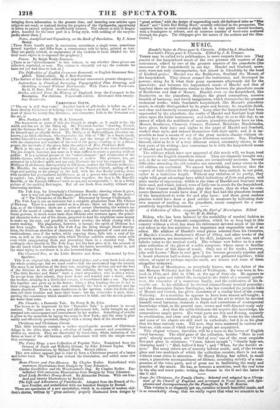M USIC .
Handers Suites de Pieces pour is Clavecin. Edited by I. Mescheles. Scarlates Piaces pour is Clavecin. Edited by J. B. Cramer.
THESE may be called twin publications, in more respects than one. They consist of the harpsichord music of the two greatest old masters of that instrument, edited by two of the greatest masters of the pianoforte (the successor of the harpsichord) in our day. Handel and Scarlatti, more- over, were.not only contemporaries,- but joined in friendship by the bond of kindred genius. Handel was the Beethoven, Scarlatti the Mozart, of the harpsichord. They almost created the instrument, and developed its powers; doing for it what their great successors afterwards did for the pianoforte: and between the harpsichord music of Handel and that of Scarlatti there are differences similar to those between the pianoforte music of Beethoven and that of Mozart. Handel, even on the harpsichord, like Beethoven on the pianoforte, displays the grand conceptions, massive breadth of harmony, and fervid imagination which characterize his greatest orchestral works; while Scarlatti's harpsichord, like Mozart's pianoforte music, is chiefly distinguished by its grow and beauty, its exquisite finish, and clear and masterly counterpoint. Long after the harpsichord had been superseded by the pianoforte, the works of Handel and Scarlatti kept their place upon the latter instrument; and indeed they do so to this day, to an extent of which the multitude of modern pianoforte-players have no idea. Mozart, Beethoven, Clementi, Cramer, Hummel, Moscheles Mendelssohn, have given their days and nights to the pages of Handel and Scarlatti, studied their style, and imbued themselves with their spirit; and it is im- possible to hear a sonata of any of the great modern classics without ob- serving how much they owe to those illustrious ancients. Nay, Thalberg himself, chief as he is of a very different school, constantly shows, in the best parts of his writings how conversant he is with the harpsichord musk of Handel and Scarlatti.
The editions which have now appeared of this music will, we hope, tend to improve the English pianoforte school. They are elegantly brought out; and, as far as our observation has gone, are scrupulously accurate. Several difficulties attending the old notation are removed, and many errors in the old editions are corrected. We cannot help thinking, however, that the respect of both editors for the original text has been carried, in one point, rather to a fastidious length. Without any violation of its parity, they might with great advantage have added indications efforts and piano, and other marks of expression; which in the time of Handel and Scarlatti were little used, and which, indeed, were of little use in music for the harpsichord. But when Cramer and Moscheles play this music, they do what its com- posers themselves would. have done if they had had the pianoforte instead of the harpsichord to wiite for and play upon: and these great modem. pianists would have done a good service to amateurs by indicating their own manner of reading, on the pianoforte, music composed for a com- paratively imperfect instrument. —


























 Previous page
Previous page